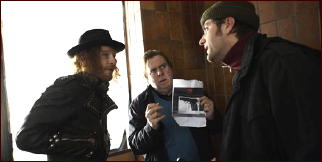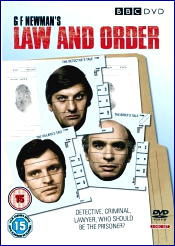Tue 26 Jan 2010
A TV Review by Mike Tooney: ALFRED HITCHCOCK HOUR “Nothing Ever Happens in Linvale.”
Posted by Steve under Reviews , TV mysteries[6] Comments
“Nothing Ever Happens in Linvale.” An episode of The Alfred Hitchcock Hour (Season 2, Episode 6). First air date: 8 November 1963. Fess Parker, Gary Merrill, Phyllis Thaxter, George Furth, Burt Mustin, Sam Reese. Teleplay: Richard Levinson and William Link; screenplay: Robert Twohy based on his story in Ellery Queen’s Mystery Magazine (title and issue unknown). Director: Herschel Daugherty.
Mrs. Logan (Phyllis Thaxter), a widow living alone, is alarmed. From her upstairs bedroom window she has watched the suspicious behavior of her next door neighbor, Harry Jarvis (Gary Merrill), and feels it’s time to call in the authorities.
In this instance, “the authorities” consist of mild-mannered Sheriff Ben Wister (Fess Parker) and his semi-official and somewhat excitable deputy Charlie (George Furth).
Mrs. Logan details the late-night digging around she has seen Harry Jarvis doing, and concludes Jarvis has done in his wife and buried her in his backyard. The sheriff investigates as far as he can, but tells her that based on the evidence he has, Harry has done no wrong. Nevertheless, responding to Mrs. Logan’s urgings to DO something before this killer gets away with murder, he takes it upon himself to dig up Jarvis’s back yard, where he does find a body — but not the one he was expecting ….
This story is a clever variation on Hitchcock’s Rear Window, but if you’ve seen that film you’ll be at a disadvantage here because of preconceptions and expectations that you may have brought with you from the movie — and I think the screenwriters are clearly counting on that. (To say more would be to say too much.)
Among Gary Merrill’s crime/suspense screen credits are Where the Sidewalk Ends (1950), A Blueprint for Murder (1953), Witness to Murder (1954), and The Human Jungle (1954). He also commanded a bomber group in Twelve O’Clock High (1949) and was nearly eaten by a giant crab in Mysterious Island (1961).
Amiable Fess Parker’s screen persona usually led him to being cast as good guys — e.g., Davy Crockett and Daniel Boone on TV — so he never had much of a chance at being a bad ’un.
Phyllis Thaxter was equally adept at being a victim, a perpetrator, or just the girl next door. She appeared in a noir Western, Blood on the Moon (1948); in Act of Violence (1948), Women’s Prison (1955), as well as in nine Alfred Hitchcock TV series episodes (is that a record?). She was also Clark Kent’s adoptive mother in Superman (1978).
Follow the link to Hulu to see why “Nothing Ever Happens in Linvale.”






